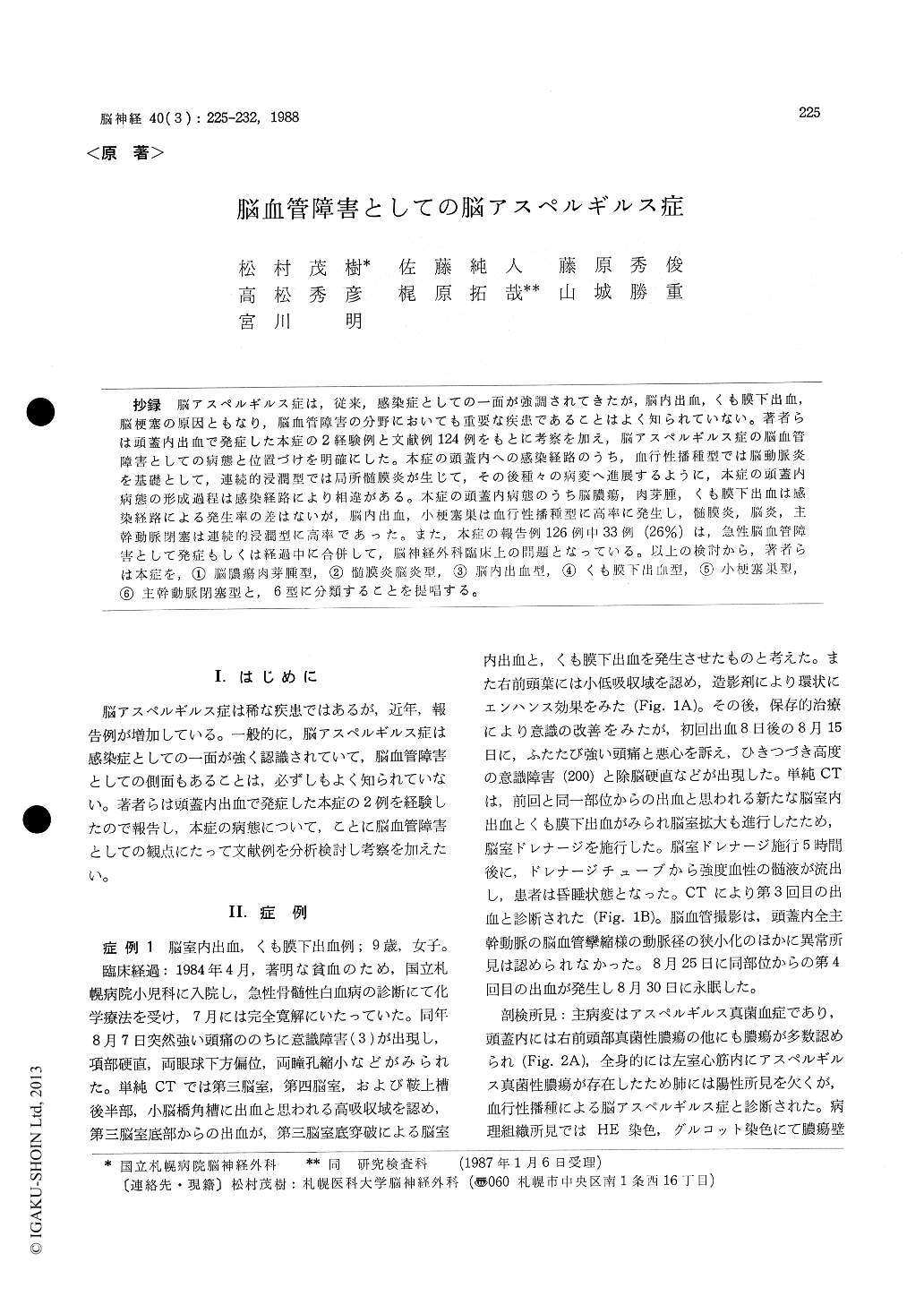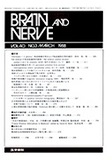Japanese
English
- 有料閲覧
- Abstract 文献概要
- 1ページ目 Look Inside
抄録 脳アスペルギルス症は,従来,感染症としての一面が強調されてきたが,脳内出血,くも膜下出血,脳梗塞の原因ともなり,脳血管障害の分野においても重要な疾患であることはよく知られていない。著者らは頭蓋内出血で発症した本症の2経験例と文献例124例をもとに考察を加え,脳アスペルギルス症の脳血管障害としての病態と位置づけを明確にした。本症の頭蓋内への感染経路のうち,血行性播種型では脳動脈炎を基礎として,連続的浸潤型では局所髄膜炎が生じて,その後種々の病変へ進展するように,本症の頭蓋内病態の形成過程は感染経路により相違がある。本症の頭蓋内病態のうち脳膿瘍,肉芽腫,くも膜下出血は感染経路による発生率の差はないが,脳内出血,小梗塞巣は血行性播種型に高率に発生し,髄膜炎,脳炎,主幹動脈閉塞は連続的浸潤型に高率であった。また,本症の報告例126例中33例(26%)は,急性脳血管障害として発症もしくは経過中に合併して,脳神経外科臨床上の問題となっている。以上の検討から,著者らは本症を,①脳膿瘍肉芽腫型,②髄膜炎脳炎型,③脳内出血型,④くも膜下出血型,⑤小梗塞巣型,⑥主幹動脈閉塞型と,6型に分類することを提唱する。
Cerebral aspergillosis is one of the most common mycotic infections in the central nervous system causing different clinical features such as brain abscess, granuloma, meningitis, and encephalitis. Cerebral aspergillosis, however, may lead to a cerebral vascular accident such as intracranial hemorrhage or cerebral infarction. In this report. we present two patients with cerebral aspergillosis accompanied by intracranial hemorrhage. A total of 124 reported cases of cerebral aspergillosis are reviewed to ascertain the pathogenesis of the associated vascular lesion.
The first patient was a 9-year-old girl, who de-veloped drowsiness with a headache during the medical treatment for acute myelocytic leukemia. CT disclosed subarachnoid and intraventricular hemorrhage. The autopsy revealed that the asper-gillus arteritis was the cause of repeated hemor-rhage.
The second patient was a 15-year-old boy with allergic purpura and renal failure, who suddenly developed a stupor with convulsive seizure. CT disclosed an intracerebral hemorrhage in the right parieto-occipital area. The patient gradually dete-riorated and died in spite of the surgical removal of the hematoma. The autopsy revealed that the hemorrhage was caused by the aspergillus arteritis.
Cerebral aspergillosis has two routes of infection to the central nervous system : hematogeneous dissemination from the distant site (usually the lung) and direct extension from the contiguous site (usually the paranasal sinuses or orbit). The primary mechanism of neuropathology is different between these two types. Primary cerebral arte-ritis is most often seen in patients with the former type, whereas primary basal meningitis occurs in the latter.
The incidence of clinico-pathological features isdifferent between hematogenous dissemination type and direct extension type. In 81 cases with hematogenous dissemination, brain abscess and granuloma formation is found in 56 cases (69%), meningitis and encephalitis in 22 cases (27%), intracerebral hemorrhage in 30 cases (37%), sub-arachnoid hemorrhage in 12 cases (15%), cerebral infarct foci in 29 cases (36%), and occlusion of the major artery in 8 cases (10%). On the other hand, in 23 cases with direct extension, brain abscess and granuloma is found in 15 cases (65%), meningitis and encephalitis in 11 cases (48%), intracerebral hemorrhage in 2 cases (9%), subarachnoid hemor-rhage in 3 cases (13%), cerebral infarct foci in 4 cases (17%), and occlusion of the major artery in 7 cases (30%). The incidence of brain abscess, granuloma and subarachnoid hemorrhage is almost the direct extension type. The incidence of intra-cerebral hemorrhage and cerebral infact foci in the hematogenous dissemination type is higher than in the direct extension type. On the other hand, the incidence of meningitis, encephalitis and occlusion of the major artery is higher in the direct exten-sion type.
In 126 cases of reported cerebral aspergillosis, 33 cases (26%) had signs and symptoms of cerebral vascular accident similar to the previously men-tioned two cases. Based on these studies, the authors clarify that cerebral aspergillosis forms a definite entity in the cerebral vascular accident, and propose the following new classification of cerebral asper-gillosis (1) brain abscess and granuloma, (2) meningitis and encephalitis, (3) intracerebral hemorrhage, (4) subarachnoid hemorrhage, (5) cerebral infarct foci, and (6) occlusion of major artery.

Copyright © 1988, Igaku-Shoin Ltd. All rights reserved.


